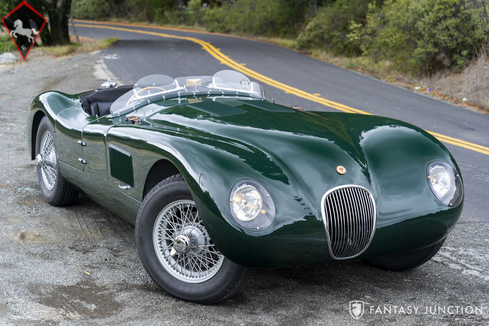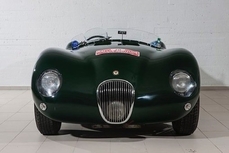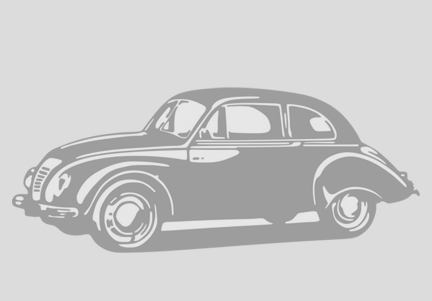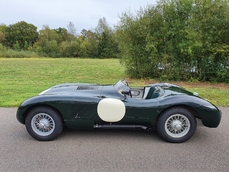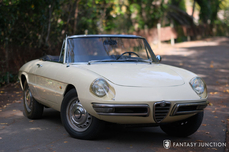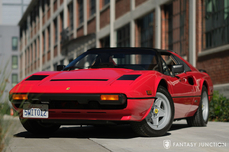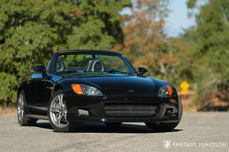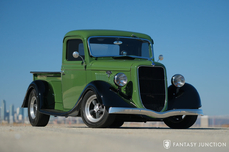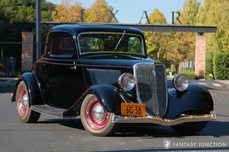Jaguar C-Type 3.4 Liter Inline Six 1954
General description :
1952 Jaguar C-Type Recreation by Proteus
s/n 672749, Engine no. W5758-8
British Racing Green with Black Interior
Among the most celebrated of sports cars, Jaguar has continually offered innovative designs, exceptional competition cars, and tremendous engineering capacity. The legendary C-Type Jaguar embodies all these traits. Beginning with the Malcolm Sayer body design, the graceful aerodynamic body is itself a work of art. This functional and beautiful design was coupled with the twin cam XK series engine and disc brakes, making C-Types dominant forces in races, winning at Le Mans in 1951 and again in 1953. With a mere 52 examples assembled at the factory, today some of the finest C-Types are selling for eight figures at premium auctions. For the motoring enthusiast who seeks the experience of such a great car, a faithful re-creation, uniting authenticity with upgraded engineering, makes for an enjoyable motorcar with the performance and visual heritage to properly celebrate the original.
This Jaguar C-Type was constructed in the 1980s with careful attention to originality and fabrication, befitting a car of this status. At that time, Proteus, now a premier fabrication house creating some of the best C-Type replicas in the world, had just started their operation. This car was assembled using an original 1950s 3.4 Liter Jaguar engine procured from an XK120 and rebuilt for this application. The 1952 XK120 ID tag was riveted to the firewall at assembly and indicates the engine number, which matches with the number stamped on the head currently in the car. Large SU H8 sand cast carburetors were installed with a handmade aluminum airbox, feeding the twin-cam engine. A Moss gearbox was used for shifting duties much as they were in original Jaguars. Dunlop disc brakes were mounted at all four wheels and correctly painted 16” wire wheels were installed. Proteus assembled all their cars using aluminum coachwork over a specially constructed chassis with attention to original specifications and body design, closely matching the original cars. The hand crafted aluminum body involved 600 hours of fabrication before being mated to the chassis. Period correct details were used throughout the exterior and interior, in order to capture the essence of the original C-Type racing cars and still deliver reliable street performance for enthusiast driving.Today this car presents very nicely, having been regularly serviced and recently tuned and adjusted to ensure proper operation. Originally commissioned by an enthusiast who specified the car be as close to factory original as fiscally possible, the build was carried out and completed with only a few miles put on the car under his ownership. The car was then sold to the second owner and subsequently offered for sale by Fantasy Junction in 2017. The current owner purchased this car from Fantasy Junction that same year adding only minimal miles to it under his ownership. The car is finished in the quintessential British Racing Green, which has been enjoyed and generally preserved over the years, showing only mild evidence of road use in a few areas, and a few scrapes noted at the rear of the car. The odometer indicates fewer than 2,000 miles have accumulated during the restrained life of this C-Type Recreation. The paint is glossy throughout and captures the fluidity of the undulating fender lines much as the original did more than half a century ago. The construction of the alloy body panels is exceptional, with excellent fit and finish, showing only minor areas of use over time - a further testament to the Proteus quality and allegiance to the original. The visual delight continues throughout the exterior of the car with very nice trim, lighting, properly nested side exhaust, clear headlight covers, and correctly painted wire wheels. New tires were fitted in 2019. The interior delivers a handsome combination of racing history and purposeful features. Instruments are neatly clustered behind a beautiful wood-rimmed steering wheel adorned with the Jaguar emblem. The dial faces on the instruments (many of them rare now and hard to find) are in excellent condition with clear glass and finely detailed indications. The fuel gauge needle migrates a bit unpredictably while in motion. The black seats are accurately presented, nested in the race-trimmed cockpit, revealing just a few silver-painted frame tubes, inclusive of the C-Type’s preeminent racing heritage. The cockpit is both purposeful and engaging, inviting one to drive with ambition and intent, as there are little distractions to deter your focus. The aircraft inspiration, low windscreen, and racing heritage, combined with just a hint of elegant material touches deliver a wonderful feel to the interior of the car.Under the hood, the craftsmanship continues to inspire onlookers with visions of vintage Le Mans racing. The engine is prominently featured with dual carburetors, a handmade aluminum airbox, and polished cam covers gleaming against the correctly finished red twin-cam C-Type head. Hardware has been appropriately updated, allowing for improvements where modern technology enhances reliability and safety. These improvements are evident when driving this well-balanced and properly engineered car. The engine fires to life eagerly and settles into a smooth but slightly raspy exhaust and excellent throttle response, offering a symphony of motorsports brilliance with each tap of the throttle. The driving experience is very satisfying, cohesive, and engaging. Even the most comfortable and familiar drivers of vintage sports cars will appreciate the balance and excitement driving in this car. Shifting is smooth and easy with positive feel and good clutch engagement. Pressing harder on the throttle there is no hesitation at highway speeds through all gears as the car pulls strong. Disc brakes deliver good grip, providing ample stopping power, while the live rear axle works surprisingly well in this package, delivering good grip and confidence even in tighter corners. A masterpiece of automotive design and racing excellence, the Jaguar C-Type is a dream only a few can aspire to own. However, with a contemporary recreation of the highest order, fortunate enthusiasts are afforded the opportunity to experience both the history and motoring excellence of these great cars. This stunning C-Type is ready to deliver all the promise of the original design, exceptional engineering, and improved reliability, free from the costly tethers of museum curation and preservation.
https://fantasyjunction.com/inventory/1952-jaguar-c-type-by-proteus/overview
1954 Jaguar C-Type 3.4 Liter Inline Six is listed sold on ClassicDigest in Emeryville by Fantasy Junction for Not priced.
Car Facts
Car type : Car Make : Jaguar Model : C-Type Model Version : 3.4 Liter Inline Six Engine size : 3.4 Model Year : 1954 Location : Emeryville Vehicle Registration : Normal
Sold
Seller Information
Sold
People who viewed this Jaguar C-Type also viewed similar Jaguar listed at ClassicDigest
Other cars listed for sale by this dealer
About Jaguar
Ah, the story of Jaguar, from its early days as the SS Cars Ltd. to its pinnacle with the D-type, and the street-going evolution in the form of the iconic E-type. There's something quintessentially British about this tale, and I'll narrate it as a British journalist might.In the Beginnings:
Our journey into the world of Jaguar begins in the 1930s, when a company known as SS Cars Ltd. emerged. Despite the unfortunate coincidence of their initials with the rising political tensions in Europe, they started producing stylish and performance-oriented cars. The SS 100, introduced in 1936, was a symbol of elegance and speed, setting the stage for what would become Jaguar.
The Birth of Jaguar:
As the shadows of World War II loomed, SS Cars Ltd. wisely decided to disassociate themselves from the SS initials. Thus, in 1945, they officially became Jaguar Cars Ltd., a name that would soon be synonymous with British luxury and performance.
The XK Series:
Jaguar's post-war era brought us the XK 120, a true sensation in 1948. With its sleek design and a powerful 3.4-liter inline-six engine, it became the world's fastest production car. The XK 120 was the blueprint for what lay ahead – Jaguars that blended style with speed in a uniquely British fashion.
The D-type Dominance:
Then came the D-type, a true racing legend. Introduced in 1954, it won Le Mans three times in the 1950s, showcasing Jaguar's engineering prowess. With its innovative monocoque construction and the iconic fin at the back, the D-type was the apex of Jaguar's motorsport success.
The E-type Emergence:
But the true turning point arrived in 1961 with the introduction of the E-type, often described by Enzo Ferrari as "the most beautiful car ever made." Its long bonnet, curvaceous body, and a 3.8-liter engine delivering exhilarating performance made it an instant classic. The E-type was not just a car; it was a work of art on wheels, and it could hit 150 mph on the road.
Street and Racing Success:
The E-type's beauty was matched by its capability on the track. The lightweight E-types were particularly successful in various racing events, cementing Jaguar's reputation as a force to be reckoned with in motorsport.
The Age of Refinement:
As we delve deeper into the Jaguar story, we find that the 1950s and 1960s were an age of refinement and expansion. Alongside the magnificent D-type and the E-type's iconic emergence, Jaguar introduced models that further solidified its reputation for luxury and performance.
The MK2:
In the late 1950s, Jaguar unveiled the MK2, a sports sedan that combined elegance with power. This sleek four-door saloon was a favorite of bank robbers and law enforcement alike, thanks to its exceptional speed and handling. The MK2 was a symbol of Jaguar's ability to blend sophistication with performance and had a successful racing career as well.
The XJ6:
Fast forward to 1968, and Jaguar launched a car that would define luxury saloons for decades to come – the XJ6. It was a masterpiece of engineering and design, featuring a smooth inline-six engine, independent rear suspension, and a spacious, beautifully appointed interior. The XJ6 was a symbol of British elegance and provided a ride so smooth that it seemed to glide over the road. It became the flagship model for Jaguar and set the standard for luxury saloons, showcasing a level of refinement that left competitors in awe.
The Blend of Classic and Modern:
While the MK2 and XJ6 represented the evolution of Jaguar's saloon cars, they maintained the brand's commitment to performance and luxury. These cars didn't just belong on the racetrack; they were equally at home cruising down the grand boulevards or gliding through the English countryside.
The Challenges of Change:
However, as the 1970s arrived, Jaguar, like many British automakers, faced financial challenges and changes in ownership. The British Leyland era brought both opportunities and struggles, as the brand navigated through various mergers and transitions.
Nevertheless, the legacy of the MK2 and XJ6, along with the D-type and E-type, continues to define Jaguar as a manufacturer that combines timeless elegance with a spirit of performance. These classic models, whether driven on winding roads or parked as collectors' treasures, serve as a testament to Jaguar's enduring presence in the world of automotive excellence.
The Jaguar story, from its early days as SS Cars Ltd. to the creation of automotive icons like the E-type, MK2, and XJ6, is a journey that reflects the very essence of British motoring – a blend of luxury, power, and style that continues to captivate enthusiasts and connoisseurs alike.
